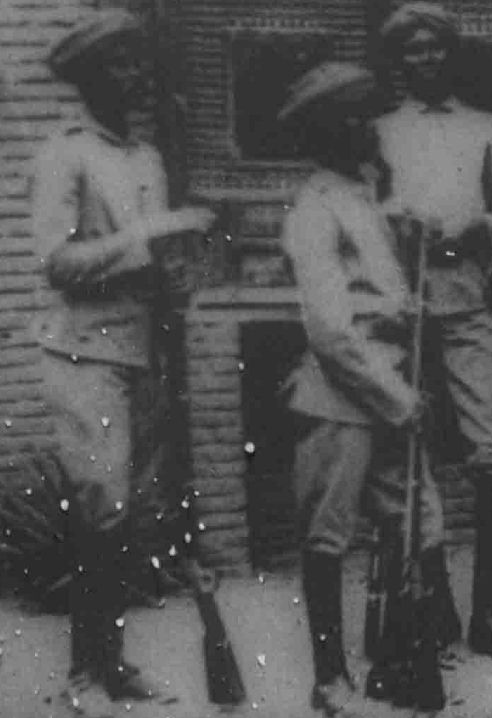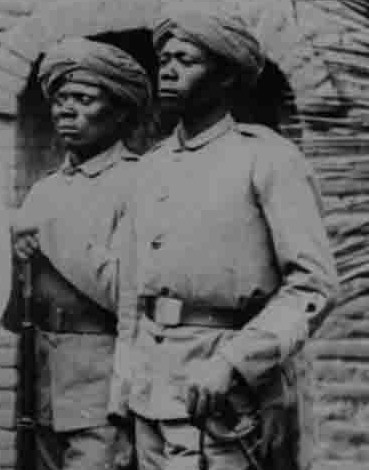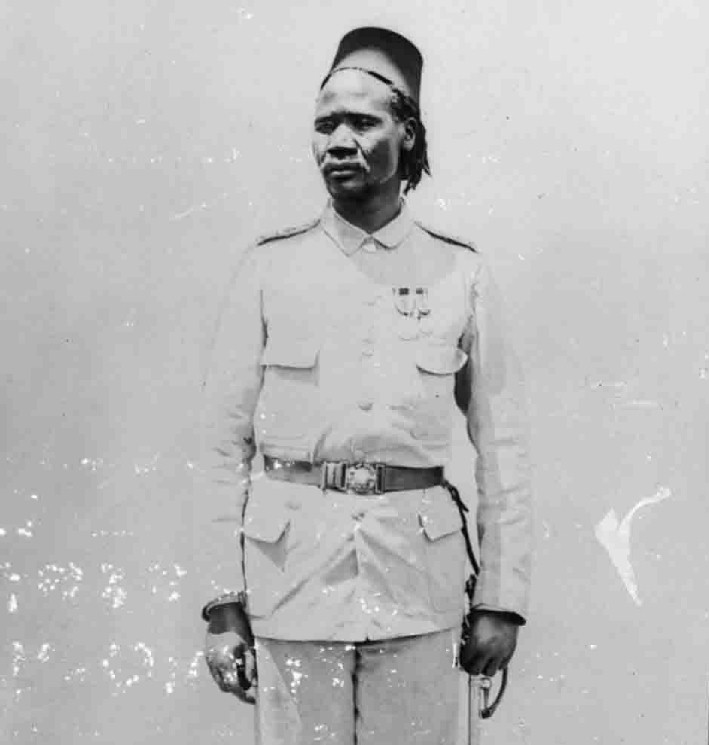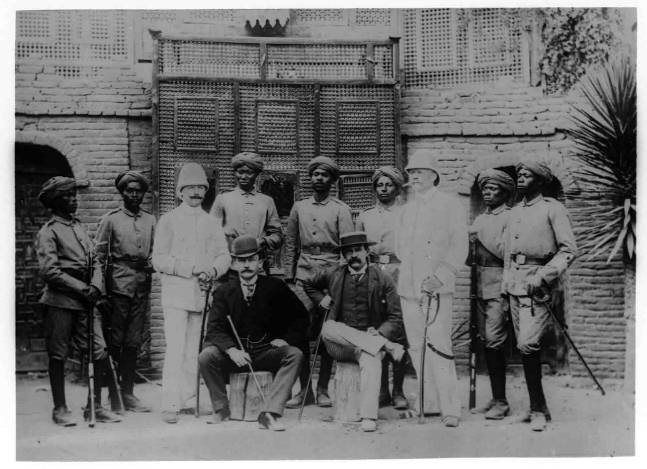-
Posts
190 -
Joined
-
Last visited
-
Days Won
1
Content Type
Profiles
Forums
Blogs
Gallery
Events
Store
Posts posted by Chris Dale
-
-
Chris,
This is the M01 winter tunic for members of the East Asian Occupation Brigade, in this case the 1st Regiment of infantry. I am not sure when these troops were recalled, so I can't give you an end date on the use of these. I am sure you can find their history on the Web.
Chip
I agree with Chip, it is the field grey uniform of the East Asian Occupation Brigade introduced in 1901. These uniforms were replaced in 1904 with a slightly different tunic with pointed pocket flaps.
Cheers
Chris
0 -
Thanks XXX and MReid for the rifle identification. It looks on this page to be the same-
http://www.angelfire.com/vt/milsurp/rrb.html
I've updated the page on my website ( www.germancolonialuniforms.co.uk ) about Wissmanntruppe Askaris with the information you chaps have supplied (and of course given credit at the bottom of the page). Also updated my page on East African Effendis, with my illustrations medal bars being more accuratley coloured. Thanks so much again for all you help.
Cheers
Chris
0 -
Thanks JJ and especially Mark for the essay on Egyptian uniforms! Great reading and all new to me, and I'm sure many other readers.
It does sound from your descriptions that these Sudanese askaris recruited into German service in 1889 took their old Egyptian uniforms with them or at least the basics of them. These uniforms then formed the basic design of future uniforms worn by the askaris of German East Africa up until the First World War. This is great news for to be be able to trace their evolution back to its roots.
It should also be noted that the other African troops recruited for German service in East Africa at this time (the Zulu and Swahilli askaris mentioned earlier in this thread) did not wear khaki uniforms at least initially. This would again lead me to think that Germany did not provide an all new khaki uniform for it's first African soldiers, they probably wore whatever they already wore or what could be found locally or easily. In the case of the Sudanese, their old uniforms.
The tunic worn by the Sudanese askaris in German service looks exactly like the khaki uniforms you describe being introduced shortly after 1883-4, as does their trousers and their puttees being dark blue.
They also wore the same red fez. Possibly the grey turban was a German addition, though grey was not generally associated with German uniforms until long after. Most German troops back home still wore Prussian dark blue at this point. I'd guess it was a coincidence and locally bought. What was German and is not seen in this photo is that they are described as wearing an imperial eagle badge on the front of the turban, possibly added after this phot was taken.
Of great interest is your description of the straw Imma around the fez and covers for it with neckshades. In around 1891 the Germans introduced what they called the Tarbusche to replace the red fez on active duty. The Tarbusche was wicker frame in the shape of the fez, with a khaki cover including a neckshade. This sounds like a direct descendent of the variations of Egyptian headdress.
The mystery still remaining is the rank insignia of the NCO, that cuff braiding... it surely can only be the old French style still in use? I've not seen anything like it on other German uniforms of the period.
Another question, can anyone identify the rifles carried by this group? The German askaris were issued Mauser Jaegerbusche 71 rifles for service in East Africa. I'm no firearms expert but these shown in the photo don't look like Mausers. Possibly their old Egyptian rifles still?
Cheers
Chris
 0
0 -
Thanks for the good work and photos on the Egyptian army of the period. The really odd thing now is why this offcier would still be wearing his old Egyptian/Ottoman uniform after he'd already been in German service long enough to win a German medal?
There are several unidentified parts of early Sudanese askari uniforms that I cannot find a German source for. Maybe one you you might recognise them as Egyptian/Ottoman.
I've attached a close up of the two chaps on the right of the first photo I posted on this thread. This uniform is usually described as being khaki, five buttoned and no pockets. This later became the standard design for Schutztruppe askari uniforms. I'm wondering if it had it's origins in the Khedive's army? Likewise the grey turban wrapped around a red fez. Would this have been worn in the Khedive's army? Also notice the NCO with the sword has some kind of looped lace on his cuff. This isn't like any German rank insignia I've seen. Could this be from the Khedive's army too? And if so does anyone have a better pic of it?
Oh... and a very merry Christmas to you all....
Cheers
Chris
 0
0 -
.... was wondering if it might be German? The double-breasted pattern with plastron often indicates cavalry status in European armies of the 19th century but I'll leave it to someone more knowledgeable to make a final judgement.....
I first thought it might be German, but on closer examination, the tops of the plastron frojnt should be scalloped on a German Ulan tunic. So I'm preferring the Egyptian option.
Cheers
Chris
0 -
Thanks Ed, that's exactly what I needed to know!
Cheers
Chris
0 -
Hello Bernard,
You are a lucky man to have such memories, thank you very much for sharing them with us.
Cheers
Chris
0 -
It certainly is good isn't it? I'm glad I stumbled across you guys!
Thanks Mark for trying to track down these chaps, and also very much for identifying the medals. Here's some further questions....
WildCard you mentioned the German medals being the "Prussian" War Service Medal. Do you know if this was a standard Prussian army award? I've only read about it being awarded to askaris (in East Africa from 1892 and in other colonies from 1893), but was it a previously existing award given to Prussian (and German) soldiers before then?
So if this bar has the original ribbons replaced on the Khedive Star and British Egypt Medal. What were the original ribbon colours?
Also does anyone recognise the uniform worn by the Effendi on the left in that PDF document. The Lancer style jacket? Is it Egyptian issue? It doesn't look to be German.
Here's another photo from the Frankfurt Univeristy Archives showing an Effendi in German East African service with two medals.
Cheers
Chris
 0
0 -
Hi Chris,
Thanks for that info. Do you know how many were repatriated? I guess your previous suggestion of the wound would now be the most likely reason.
Cheers
Chris
0 -
On a personal note: I was privileged in 1942 or 43 to have been introduced with the other members of my form to Gen.v.Lettow-Vorbeck while attending the school in Bremen named after him. Perhaps it can be understood what an impression this made!
Bernhard H. Holst
That's amazing that you met Gen von Lettow-Vorbeck in person! That must indeeed have left a great impression. Do you remember any details of the day or your impressions of him?
All the best
Chris
0 -
And to close off.... his wound badge.
I am still having trouble seeing why he was "Conditionally released" during the war when the rest of the germans were kept in POW camps... maybe because of this wound?
Hi Chris,
As I understand it only the regular Schutztruppe were kept as POWs in WW1. The reservists, volunteers and police were released on condition they did not take up arms again.
Great documents, by the way!
Cheers
Chris
0 -
I have seen such double cockades referenced at:
Thanks for quoting my website and thanks for posting such great photos. The chap with the two cockades is not from the Seebatallion, which along with the Schutztruppe (as Rick said) only wore the imperial cockade. He is also from the East Asian Expeditionary Corps, and being an army unit they wore both imperial and state cockades.
Cheers
Chris
0 -
What a great thread! Firstly thanks very much to WildCard for letting us see this bar. Secondly thanks very much to MReid for the information on Egyptian medals and amazingly indentifying the original owner!
My interest is in the German colonial troops and from this angle I hope to add some information. As Harry has said numbers of Sudanese soldiers were recruited from former Anglo-Egyptian service to form the Wissmanntruppe in 1889 to serve in German East Africa. The bulk of the troops were Sudanese, but some Egyptians and Greeks were also recruited as officers. From what I've read and seen they were still allowed to wear their old Anglo-Egyptian medals while in German service so this bar is in line with regulations.
There's a couple of photos of these men wearing both German and A/E medals on page 7 of this document from the Traditionsverband.de website-
http://www.traditionsverband.de/download/p...re_fuehrung.pdf
Can anyone identify the medals in these photos? Again they appear to wear their German medals at the front of the bar.
Ulsterman was asking about photos of the original Sudanese, here's one attached of Lt Theremin (whom Harry mentioned) with the askaris during recruitment in Cairo in early 1889. This photo is from the Frankfurt University archives.
And sorry, no Ulsterman it's unlikely any of them were at Isandhlwana. The "Zulu" askaris recruited for them Wissmanntruppe were from a spit off group of the Zulu nation and were from Portuguese East Africa.
Cheers
Chris Dale
 0
0 -
All the ones I saw in South Africa that actually came from DSWA had this stamp (different numbers of course...)
That's a great bayonet! You're right from what I've seen the DSWA bayonets have KS for Kaiserliche Schutztruppe, while East African ones are marked DOA and Cameroon ones are marked KA.
Cheers
Chris
0 -
Hi Daniel,
Thanks for quoting my website, glad it was of some use. Your tunic looks great. A couple of thing appear curious to me. The first is the lack of blue piping (although it does appear to be on the cuffs). I can't imagine how the piping on the collar and down the front would all have worn away while leaving the uniform mostly intact. There was a 1913 version of the uniform issued without piping although not many troops wore this version. The second curiosity are the buttons, the Schutztruppe usually wore buttons bearing an imperial crown. Maybe these buttons are a later addition?
Great tunic though and thanks for posting photos of it.
Cheers
Chris
0 -
If it's of any help...
Yes, the Germans in East Africa did recieve EK Is and IIs from a Hilfschiffe. Three EK Is for Von Lettow Vorbeck, Schnee and Looff. EK IIs for the crew of the Koenigsberg.
In South West Africa an award known as the Hildegard Orden was made up. It was an Iron Cross award but without actually having a real Iron Cross, they made thier own ones out of black and white ribbon. I'm not sure how many were awarded and if all of them were certifed by Berlin after the war.
The Schutztruppe in Cameroon also awarded makeshift EKs.
Cheers
Chris
0 -
Another thing that puzzles me, is the soldier sitting far left.
He has a white (probably white) collar and huge collar-tabs. His shoulder-boards look like 1st WW boards. Could that be a veterans uniform ?
As always, any information is highly appreciated.
Thanks in advance
Robert
Hello,
You're absolutley right there Robert it is either a re-made veterans uniform or possibly an original pre-1914 uniform. Either way it is based on the grey cloth home uniform worn by the Schutztruppe known as a Tuchuniform. The white collar and piping indicates the wearer served in German East Africa.
Cheers
Chris
0 -
 I've never seen colonial tunics without collar and cuff litzen-- I wonder if that indicates these are local reservists on maneuvers?
I've never seen colonial tunics without collar and cuff litzen-- I wonder if that indicates these are local reservists on maneuvers?Hello,
Thanks for posting the great photos. The tunic without litzen is the Kord Litewka introduced for the Schutztruppe of DSWA in 1900. It gradually replaced the tunic with Litzen (the Kord Waffenrock) and the Waffenrock was officially withdrawn in 1913.
The ammunition pouches also help date the photo. They are of a type replaced about 1906 by new ones similar except they had a button on each pouch.
I hope that helps a bit....
Cheers
Chris
0




A China armbadge mystery
in Germany: Imperial Uniforms, Headwear, Insignia & Personal Equipment
Posted
The original East Asian Expeditionary Corps of 1900 did wear state cockades, Wappen, belt buckles etc. Only from 9th Feb 1901 were new uniforms introduced with only Reichs insignia.
Yes, I agree with others here the badges may look very simialr to those worn by Police units in China such as the Tsingtao Chinese Police- http://www.seitengewehr.de/Chinesische_Pol..._Kiautschou.pdf
Cheers
Chris